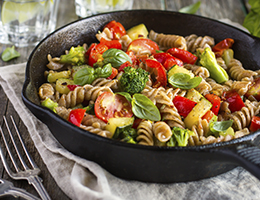
Carbohydrates, or carbs, are the body's top fuel. That's true whether you're working 9 to 5 or just relaxing at home. And that makes carbs an essential part of everyone's healthy diet.
In addition to providing everyday fuel, carbs can deliver an endurance boost during long-term, vigorous exercise, according to the Academy of Nutrition and Dietetics. That's why some endurance athletes engage in carb-loading before a sports event.
But how do you know if carb-loading is for you?
Understanding carb-loading
According to the Dietary Guidelines for Americans, all adults should get 45% to 65% of their daily calories from carbohydrates.
When carb-loading, endurance athletes exceed the recommended carbohydrate levels before an event. Doing so helps their bodies stockpile carbs, in the form of glycogen, so that they can perform longer without tiring.
Not for everyone
Again, carb-loading is for endurance athletes—those who exercise vigorously for an extended period, such as 90 minutes at a time. For instance, athletes competing in long-distance cycling, half- or full marathons, or all-day swim meets or tennis matches might benefit from carb-loading.
For such athletes, carb-loading can counter what's known as "hitting the wall." That's when, near the end of an event, many athletes run out of glycogen. Carb-loading could provide them enough stored energy to keep going.
Most people probably won't benefit from carb-loading. That's because they're not exercising long enough to deplete their glycogen stores.
Also, carb-loading may not be safe for some people—such as those with diabetes. Talk to your doctor or a registered dietitian if you're considering carb-loading.
How to carb-load
The carb-loading process is fairly simple and goes like this:
Rest. About a week before your athletic event, gradually decrease training to allow your muscles to rest and stock up on glycogen.
Eat more carbs. About two days before your event, raise your total carb intake without raising your overall calorie intake. You might try cutting back on fats to fit in more carbs.
It's best to choose carbs such as whole grains, starchy vegetables, beans and peas. These foods, which are less processed or refined, are rich in vitamins, minerals and fiber. Simple carbs, like those found in soft drinks or sweets, pack calories with little to no nutrients.
Everyday advice
Even if carb-loading is not for you, you can still use nutrition to optimize your everyday athletic performance. Here are some tips from the Academy of Nutrition and Dietetics and the American College of Sports Medicine:
- Aim to eat a healthy variety of foods overall. No single food can give you all the nutrients you need.
- Top off your tank. On training days, eat a mix of carbs and protein to fuel your workout and support your muscles. Healthful protein choices include low-fat or nonfat dairy products, lean meat, skinless poultry, fish, and beans.
- Don't eat too soon before a workout, as this may upset your stomach. For many people, eating about one to four hours before a workout will help them fuel up without bothering their stomach.
- Drink up. Have a sports drink if your workout or game lasts longer than one hour.
- Recover. Eat a snack with protein and carbs within an hour of your workout. For example, you might have a low-fat milk and fruit smoothie or a whole-grain wrap with turkey and veggies. The carbs rebuild glycogen stores; the proteins rebuild stressed muscles.
- Don't forget fats. Moderate amounts of fat can supply energy too. Healthy sources include olive or canola oil, nuts, and avocados. All fats are high in calories, so easy does it. Most people should get 20% to 35% of their daily calories from fat.
Reviewed 3/31/2024
Sources
- Academy of Nutrition and Dietetics. "4 Keys to Strength Building and Muscle Mass."
https://www.eatright.org/fitness/physical-activity/benefits-of-exercise/4-keys-to-strength-building-and-muscle-mass. - Academy of Nutrition and Dietetics. "Timing Your Pre- and Post-Workout Nutrition."
https://www.eatright.org/fitness/physical-activity/exercise-nutrition/timing-your-pre-and-post-workout-nutrition. - American College of Sports Medicine. "Creating Health Eating Platterns."
https://www.acsm.org/docs/default-source/files-for-resource-library/creating-healthy-eating-pattern.pdf. - Dietary Guidelines for America. "Dietary Guidelines for Americans."
Dietary Guidelines for Americans, 2020-2025 and Online Materials | Dietary Guidelines for Americans.